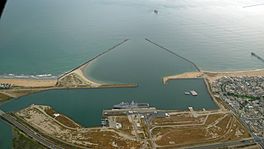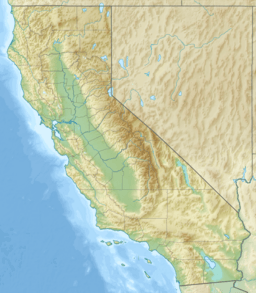Anaheim Bay facts for kids
Quick facts for kids Anaheim Bay |
|
|---|---|

Aerial view of the Anaheim Bay entrance, showing the inner harbor in front center and the outer harbor directly beyond (between the jetties). Huntington Harbor is off to the left (southeast). City of Seal Beach and Seal Beach Pier are visible to the right.
|
|
| Location | Orange County, California |
| Coordinates | 33°44′06″N 118°05′38″W / 33.735°N 118.094°W |
| Primary outflows | Pacific Ocean |
| Max. depth | 43 ft (13 m) |
Anaheim Bay is a large harbor and wetland area in Orange County, California. It's located on the Pacific Ocean coast, right next to Seal Beach, California. The bay is made up of several connected parts.
When people say "Anaheim Bay," they usually mean the deep-water harbor used by the United States Navy. Further south, you'll find Huntington Harbor, which is for smaller private boats. There's also Bolsa Bay, which is a salty estuary (where a river meets the sea). Around the bay, there are hundreds of acres of salt marshes. These are some of the biggest natural marsh habitats left in Southern California.
Contents
What is Anaheim Bay Like?
The entrance to Anaheim Bay is in the far western part of Orange County, close to the Los Angeles County border. The bay, along with its harbors and wetlands, stretches about 7 miles (11 km) southeast from Seal Beach towards Huntington Beach. A long, narrow strip of land, called a barrier beach, protects these areas. This is where places like Surfside, Sunset Beach, and Bolsa Chica State Beach are located. Nearby, you'll find Los Alamitos Army Airfield and Naval Weapons Station Seal Beach.
Harbors in the Bay
The main part of Anaheim Bay has two deep-water harbors: an outer one and an inner one.
- The outer harbor is man-made and shaped like a triangle. It's about 94 acres (38 ha) big and kept deep enough for large ships. Two long walls, called breakwaters, protect it.
- The inner harbor is natural but has been dug deeper to keep a minimum depth of 13 feet (4.0 m). It's about 96 acres (39 ha) in size. A channel connects the two harbors.
To the southeast is Huntington Harbor. This is a long, narrow area of about 153 acres (62 ha) with homes and places for boats. It used to be a shallow lagoon, but now it's dredged to 11 feet (3.4 m) deep for small boats. It connects to the inner deep-water harbor through a channel.
Wetlands and Islands
North of Anaheim Bay is the Anaheim Salt Marsh, which is part of the Seal Beach National Wildlife Refuge. This refuge has over 800 acres (320 ha) of mostly salt marshes. These marshes are connected to the bay by tidal channels. At high tide, about 131 acres (53 ha) of this area is open water.
The salt marsh also has Hog Island, which is the only natural island in the bay area. NASA Island was created in the 1960s for rocket testing. These islands now offer about 65 acres (26 ha) of dry land within the refuge. Because the refuge is inside a naval base, visitors can't easily access it.
Connected to the southeast end of Huntington Harbor is Bolsa Bay. This area still has many of its original wetlands. The Bolsa Chica wetlands are the largest coastal wetlands left in California between Monterey Bay and the Tijuana River. They cover 1,449 acres (586 ha) of salt flats, lagoons, and tidal streams. Gates control the water level between Bolsa Bay and Huntington Harbor.
Bolsa Bay used to be separate from the ocean. But in the early 1900s, its natural opening to the ocean filled with sand. This happened after a man-made channel was dug to link it to Anaheim Bay. In the early 2000s, the bay's original ocean opening was reopened. This helped bring back the natural tides, which is good for the local plants and animals.
Rivers and Channels
The San Gabriel River flows into the sea less than a mile (1.6 km) west of Anaheim Bay. The Santa Ana River mouth is about 11 miles (18 km) to the southeast. Several smaller streams also flow into the bay. Today, most of these streams are in channels to help prevent floods.
There are also several important channels:
- The Anaheim-Barber City Channel is about 8.65 miles (13.92 km) long. It starts in Anaheim and flows through several cities before reaching the Anaheim Bay Marsh.
- The Westminster Channel is about 7.91 miles (12.73 km) long. It joins the Anaheim–Barber City Channel near the bay.
- The East Garden Grove-Wintersburg Channel is the longest at 11.59 miles (18.65 km). It empties into Bolsa Bay.
How Anaheim Bay Formed
Anaheim Bay is located at the mouth of Sunset Gap. This is one of many openings in the low hills along the Orange County coast. These gaps were formed about 40,000 years ago during the last Ice Age. At that time, the sea level was much lower. Rivers carved valleys into the land. When the ice melted and sea levels rose, these valleys filled with ocean water, creating bays like Anaheim Bay.
The area is also part of the historic floodplain of the San Gabriel and Santa Ana Rivers. These rivers used to change course often and would fill the coastal bays with mud and sand. Today, these rivers don't flow directly into Anaheim Bay. But thick layers of sediment show that they did in the past.
A Brief History of Anaheim Bay
In its natural state, Anaheim Bay was the outlet for huge areas of salty marshes. These marshes stretched across what is now parts of Los Angeles and Orange Counties. The Anaheim Bay marshes alone covered more than 5,000 acres (2,000 ha). These wetlands were full of ponds, streams, and bogs, with meadows and forests nearby. Anaheim and Bolsa Chica bays were originally separate, each with its own opening to the ocean. They were only connected by a man-made channel in 1899.
The wetlands of Anaheim Bay were rich with fish and large animals, like coyotes and even grizzly bears. This made it a great place for early Native Americans to live. People might have lived here as early as 38,000 BC.
Because it was one of the few safe natural places for ships to stop along the Southern California coast, Anaheim Bay has been important for a long time.
- During the Mexican–American War, a French ship trying to bring supplies to the Mexicans was stopped here.
- During the American Civil War, a Union Army base was set up to protect the harbor.
In 1868, a company was started to operate Anaheim Harbor as a port. Goods were brought to the harbor from far away places like San Bernardino, California and Salt Lake City.
In 1862, a huge flood from the Santa Ana River changed things. The river "captured" several streams that used to flow into Anaheim Bay. This meant less fresh water flowed into the bay, making it saltier. Between 1854 and 1949, the bay lost 30 percent of its area. This was mostly due to sand building up and less fresh water to wash it out. However, in 1964, some of these streams were redirected back into the bay. This happened after the Santa Ana River was put into concrete channels to prevent flooding. This helped restore the bay's natural fresh water supply.
In 1895, a group bought the Bolsa Chica marsh to turn it into a duck hunting area. They built walls to create freshwater ponds. This changed the water currents, and the natural opening of Bolsa Chica Bay to the ocean became blocked. A new channel was then dug to connect Bolsa Chica Bay with Anaheim Bay, making them one continuous body of water. A dam was built to keep the freshwater level high in Bolsa Chica and prevent salt water from Anaheim Bay from coming in.
The United States Navy widened the bay entrance in 1944 and built breakwaters. This was to help Naval Air Station Los Alamitos. In 1990, the Navy suggested adding a third jetty to the bay mouth. This would separate the entrances for military ships and private boats. But this project wasn't built, partly because people worried it would affect the waves for surfing and cause beach erosion.
A project started in 2019 to make the turning basin deeper. This will allow larger ships, like amphibious assault ships, to be resupplied directly at the base instead of by helicopters.
Environmental Concerns
The United States Environmental Protection Agency says that Anaheim Bay has some pollution problems. It has high levels of certain chemicals like dieldrin, nickel, and PCBs, and the sediment (mud at the bottom) is toxic. Huntington Harbor also has contamination from chemicals like chlordane, copper, lead, nickel, and PCBs. Water running off from cities (called urban runoff) has also brought high levels of germs like E.coli into the bay.


